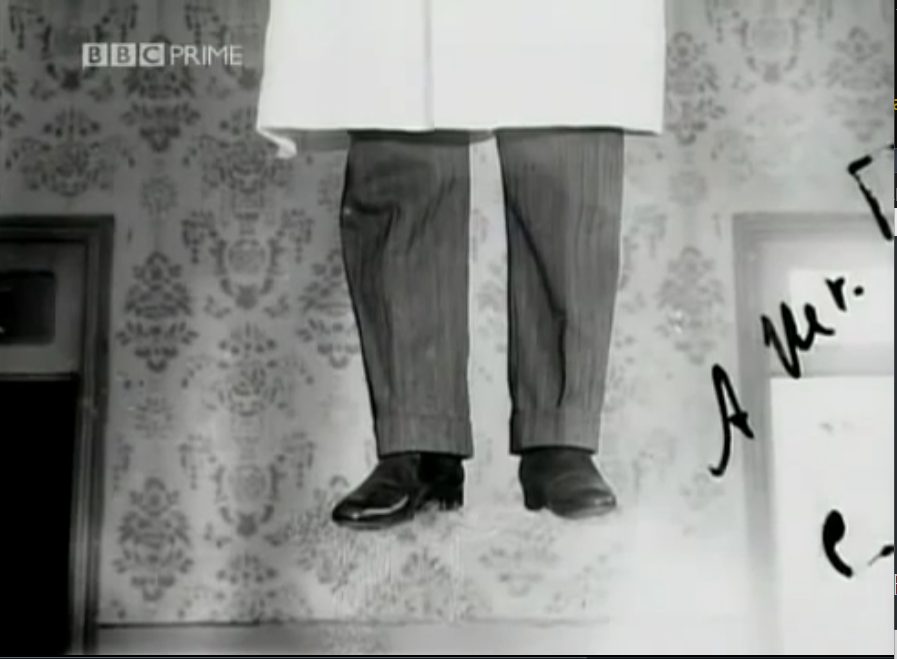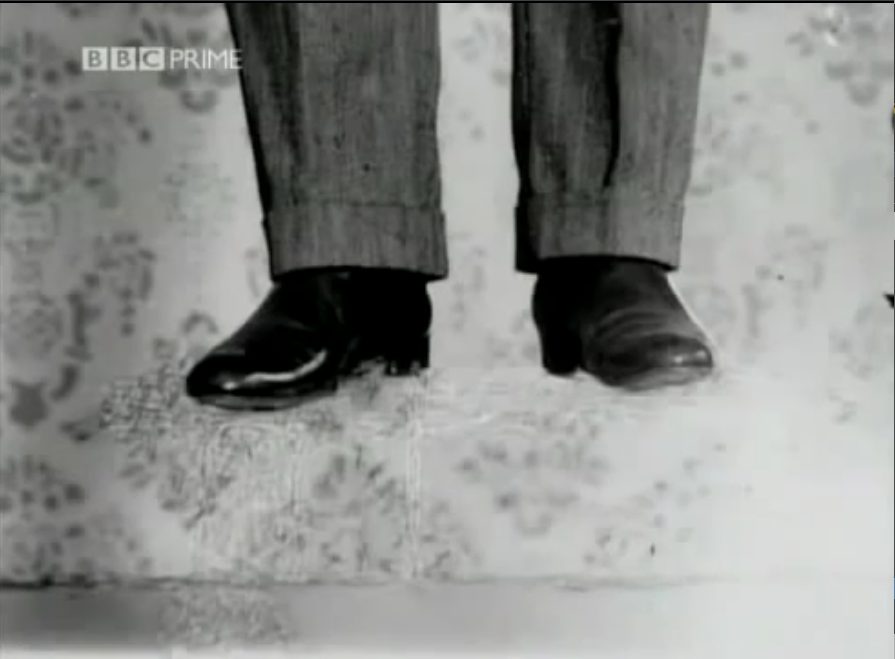BBC 制作動画 : インドのロープ・マジック記録動画映像を UK 科学者が分析したドキュメンタリー

前置き
BBC が制作した動画から、開始 34:13 までの範囲に絞る(以後は主題が逸れている)。
BBC 制作の番組…という時点で既にバイアス(= 凡庸な BBC 的判断基準)が予想されるが、その予想どおりに番組は進行している(*1)。
なお、この動画の目玉となる
- インドでのロープ・マジックの記録動画映像
については過去記事、
❏ ロープを空中に立たせて登る「ロープ魔術」の動画 ⇒ この謎を解く (途中 3) (2024-02-25)
で謎解きをした。今、あたりをつけて探したら、上の過去記事の謎解きが一目で理解できる「トリック用の紐」が amazon で販売されていた。それが下。
(*1)
概要
空中浮遊:科学、信仰、そしてトリック
複数の情報源から得られたテキストは、空中浮揚の概念をさまざまな角度から考察しています。
歴史的に、空中浮揚はインドの手品や聖人の奇跡と結びつけられ、しばしば超常現象として説明されてきました。しかし、厳密な調査によって、その多くがトリックや錯覚であることが暴かれています。現代の物理学者は、特定の条件下で物体を浮揚させることが可能であることを実験で示しており、これは振動と平衡の原理に基づいています。
一方で、人間が自力で空中浮揚するという主張は、物理法則に反するとして、懐疑的な見方がされています。結局のところ、空中浮揚は科学的な説明が可能な現象として、あるいは巧妙な手品として理解されるべきであり、超自然的な力によるものではないと結論付けられています。
目次
- 前置き
- 概要
- 詳細
- カルロス・ミラベリ(ブラジルの心霊術師)の空中浮揚写真
- ダニエル・ダグラス・ヒューム(ヴィクトリア朝の心霊術師)の空中浮揚
- TM 瞑想の空中浮揚
- 時系列
- 主要関係者
- 情報源
- 文字起こし
詳細
浮揚:科学、信仰、そしてトリックに関するブリーフィング資料
このブリーフィング資料は、「空中浮遊: 科学、信仰、そしてトリック」からの抜粋に基づき、浮揚という現象にまつわる主要なテーマ、重要なアイデア、および事実をまとめています。
I. 浮揚の概念と人類の夢
- 克服すべき重力: 浮揚は、過去100年間における人類の「重力との戦い」の最大の執着の一つでした。人類は既に空へ飛び立ち、宇宙へ進出し、地球の重力から完全に解放されることに成功しましたが、これらには膨大なエネルギーが必要でした。(0:01:37)
- 燃料を消費しない重力克服: 浮揚者の夢は、「莫大な量の燃料を燃やすことなく重力に打ち勝つ」方法を見つけることでした。(0:01:37)
- 古くからの魅惑: 空中を移動する能力、特に意志の力で困��難な地形や広大な海を越える能力は、常に人々を魅了してきました。しかし、これはこれまで「科学というよりもファンタジーや魔法」に近いものとされてきました。(0:02:23)
- 未来への可能性: 21世紀には、宇宙旅行にロケットが必要なくなる可能性も示唆されており、「強力なエンジンは浮揚の力に取って代わられる」かもしれません。SFのファンタジーが科学的事実となる日も近いとされています。(0:01:02)
II. インドの浮揚術とロープトリックの謎
- インド発祥の伝説: 浮揚の物語は「東洋から、特にインドから」生まれることが最も多く、インドは「魔法の伝統的な故郷」とされています。(0:02:23)
- インドのロープトリック: インドの浮揚術の中でも、「インドのロープトリック」は最も有名になりました。(0:03:15)
- 歴史: ロープトリックは中世にまで遡ります。(0:03:15)
- 単純なバージョン: マジシャンがロープをバスケットから出して空中に立ち上がらせ、アシスタントの少年が登って消えるというものです。(0:04:13)
- 古典的な残忍なバージョン: 少年がロープを登って消え、マジシャンが呼び戻すものの少年は拒否。マジシャンが剣を手にロープを登り、血まみれの肢体が落ちてくる。その後、マジシャンが肢体をバスケットに入れ、少年が元通りになって飛び出すというものです。(0:04:13)
- 目撃証言の信頼性: 科学者でマジシャンでもあるリチャード・ワイズマンとピーター・ラモントは、古典的なバージョンを見た者は誰もいないが、より単純なバージョンの目撃証言は「非常に信頼できる」と述べています。これらの証言は「インドに駐屯していたイギリス軍人、公務員、さらには貴族のメンバー」からもたらされており、目撃者が酔っていたり薬物の影響下にあったりしたとは考えにくいとされています。(0:04:38)
- 超常現象の可能性?: 1880年から1930年の間、多くの目撃証言がロープトリックが「自然な説明を拒否する」ことを示唆し、人々は「超自然的な何か」が起こっているのではないかと疑問を抱き始めました。懐疑的なイギリス人の中には、催眠術や燃えるヘンプの煙による薬物効果を疑う者もいました。(0:05:33)
- キャプテン・ホームズの写真: 20世紀初頭の議論の主要な触媒の一つは、1919年にキャプテン・ホームズがロープトリックを目撃し撮影したとされる写真でした。この写真は物議を醸し、彼の「輝かしい軍歴を持つ紳士」という地位がさらに注目を集めました。(0:06:40)
- マジック・サークルの懸賞: イギリスのマジック・サークルは、本物のロープトリックを披露できる者に500ギニーの賞金を提示しましたが、誰も名乗り出ませんでした。イギリスではカラチという人物が不完全なバージョンを披露しましたが、全く評価されませんでした。(0:07:21)
- フィルムの解明とトリック: イギリス兵が浮揚するロープを見ているフィルムは、後にトリックであることが判明しました。(0:08:48)
- 逆再生: ロープが空中に立ち上がる映像は、実際に��は「逆再生された映像」であり、ロープが落下する映像を反転させたものでした。(0:09:15)
- 隠されたポール: 少年がロープを登る場面のフレームごとの分析により、少年が足を動かす際に「ロープの真後ろにポール」が隠されていることが明らかになりました。(0:10:11)
- 結論: このフィルムはロープトリックの信頼できる証拠ではなく、「単なるでっち上げ(ホークス)」であったと結論付けられました。(0:10:11)
III. 科学による浮揚の可能性
- 振動による浮揚: イリュージョンやトリックにもかかわらず、物理学者は最近、「実験室条件下では、重力に逆らうトリックを実行できる」ことを証明しました。マンチェスター大学のトム・マリンズは、柔軟なワイヤーを高速で上下に振動させることで、それを垂直に立たせる機械を開発しました。(0:10:51)
- 原理: このアイデアは、ロッドや振り子の実験から生まれました。振り子を非常に速く振動させると、「重力に逆らうかのように逆さまに立たせる」ことができるという数学的な理論に基づいており、これは純粋な物理現象です。(0:11:38)
- 応用: マリンズの装置は、複数のロッドを同時に垂直に保つことができます。これは、振動する機械が、ロッドが倒れる直前に少しだけ落下させることで、ロッドを垂直に保つという一種のジャグリングのようなものです。(0:13:04)
IV. 聖人とスピリチュアルな浮揚
- 歴史と文化における浮揚: 歴史上、浮揚能力は「聖人の確かなしるし」と見なされてきました。世界の他の文化でも、「空中に浮く能力を持っていた人々は、最も精神的に進歩している」と見なされていました。(0:14:57)
- 聖ヨゼフ・オブ・カペティーノ: 200人以上のキリスト教の聖人が空中に浮くことができたとされていますが、最も有名なのは「空飛ぶ修道士」と呼ばれた17世紀の聖ヨゼフ・オブ・カペティーノです。彼は記録されただけで100回以上の浮揚を経験し、美しいものを見ると自発的に浮揚したとされています。(0:15:41)
- 懐疑的な視点: 心霊研究家のジョー・ニッケルは、人間の浮揚の証拠に対して懐疑的です。彼は、聖ヨゼフ・オブ・カペティーノの行為は、非常に敏捷な人物が「数回の素早い跳躍で、祭壇やバルコニーに登る」ことだった可能性を指摘しています。(0:16:29)
- 現代の視点: 現代の観点から見ると、大いなる運動能力を持つアスリートがいるため、17世紀の人々を驚かせたような現象も、「もはやそれほど簡単に感動するものではない」とされています。(0:17:24)
V. マハリシ・マヘーシュ・ヨーギーとヨーガの飛行
- TMとヨーガの飛行: 1960年代には、インドの聖者、特にマハリシ・マヘーシュ・ヨーギーが浮揚への関心を再燃させました。彼は超越瞑想のコースを受けた者が「空を飛ぶことを学ぶ」ことができると主張し、彼のコースは一大ビジネスとなりました。(0:18:00)
- 量子物理学による説明: マハリシの信者たちは、ヨーガの飛行が神秘的なだけでなく、瞑想の物理的な効果であると主張しています。物理学者ジョン・ハゲリンは、量子物理学の法則によって「心が物質を制御できる」ため、浮揚が可能であると主張しています。彼は、ヨーガの飛行が「ニュートンの重力法則やアインシュタインの一般相対性理論に逆らう」ものであると述べています。(0:20:00)
- 重力への「支配」: 彼らは、浮揚は重力と戦うのではなく、「重力を支配すること」であり、空間と時間の湾曲を変えることで、重力が引っ張るのではなく押し上げるようになると考えています。(0:21:41)
- 「ホッピング」としての認識: しかし、ヨーガの飛行を目撃したすべての人々が、飛行者が重力から逃れていると信じているわけではありません。多くは「ホッピング」のように見えると指摘しています。信者たちは内的な経験は「飛んでいる」ものであり、ホップして滑る「素晴らしい感覚」だと主張しています。(0:22:26)
- マハリシ自身の飛行: マハリシ自身が本当に飛行できるのかという疑問に対し、インドの心霊研究家プレマナンドは、「もしマハリシがスピリチュアルな力で飛べるなら、な��ぜインド中を飛ぶのに6機のヘリコプターが必要なのか?」と疑問を呈しており、その答えは未だに得られていません。(0:23:36)
VI. 浮揚の物理的困難とトリックの解明
- 重力の法則との矛盾: 浮揚は「重力の法則を皮切りに、懐疑的であるべき多くの理由」があります。目に見える証拠にもかかわらず、「物理法則は物体や個人が浮揚することを非常に困難にしています」。(0:24:07)
- 浮揚の二つの方法と問題点:
- エネルギーによる上昇: 上向きに噴出するエネルギーがあれば可能ですが、ニュートンの第三法則により、必ず「同等かつ反対の反作用」が存在します。ロケットの噴射のように、上向きの力があれば下向きの力も生じます。しかし、ヨギが空中を浮遊する際に、そのような反作用は見られません。(0:25:38)
- 重力の排除: 重力を排除できれば可能ですが、そうすると地球の自転による遠心力の影響を受けます。もしマジシャンが本当に女性を浮かせたなら、彼女はすぐに追跡しなければならなくなり、「壁にぶつかったり天井に浮上したり」するでしょう。屋外であれば、地球から加速しながら離れていくでしょう。(0:26:50)
- 重力排除時の軌道: 重力を打ち消した場合、人は空中に留まるのではなく、地球の自転の方向へ、地表から接線方向に直線的に離れていくことになります。そして、��「重力が最も上り坂になる場所」、つまり宇宙で最も質量が少ない場所へ向かっていくでしょう。(0:27:31)
- インドのヨギのトリック: 長年ヨギの秘密を探求してきたインドの心霊研究家プレマナンドは、空中浮揚の秘術が「精神的な高揚の結果ではない」ことを発見しました。デモンストレーションを行うヨギのローブの下には、「頑丈な鉄の棒」が隠されており、それがヨギの全体重を支え、地面に固定されていました。これは何百年も使われてきたトリックです。(0:29:04)
VII. 西洋の心霊術師による浮揚と写真のトリック
- カルロス・ミラベリ: 20世紀の有名な心霊術師、ブラジルのカルロス・ミラベリは、彼の浮揚によって多くの人々に超常的な力を信じさせました。(0:30:01)
- ダニエル・ダグラス・ヒューム: ヴィクトリア朝時代のアメリカ生まれの心霊術師ダニエル・ダグラス・ヒュームは、「決して暴かれることのなかった心霊術師」として知られ、米国からロシアに至る上流社会にその才能を信じさせました。(0:30:37)
- 1868年12月の事件: 1868年12月のある夜、ヒュームは友人のアデア卿らを巻き込んだ交霊会で不可解な浮揚を披露しました。アデア卿の証言によると、ヒュームは「体が伸びて空中に持ち上がり」、その後隣室の窓から別の窓へ現れたとされています。(0:31:08)
- 目撃者の信頼性: アデア卿とその友人たちは高い社会的地位にあったため、彼らの証言は広く疑問視されることなく受け入れられました。(0:33:14)
- 謎: ヒュームがどのように部屋から部屋へ移動したのかは不明ですが、ロープを張った可能性も示唆されています。(0:32:28)
- 写真の改ざん: カルロス・ミラベリの浮揚写真は、「ネガが改ざんされており、ミラベリが立っていた脚立が巧妙に消されている」ことが明らかになりました。(0:33:57)
まとめ
浮揚は、古くから人類の想像力を掻き立ててきた夢であり、科学、信仰、そしてトリックが複雑に絡み合ってきました。歴史を通じて多くの目撃証言や物語が語られてきましたが、その多くはイリュージョンやトリック、あるいは目撃者の誤解によるものでした。物理学の法則は、人間が特別な装置なしに重力に逆らって浮揚することを極めて困難にしていることを示しています。しかし、科学技術の進歩により、振動を用いた浮揚など、特定の条件下での浮揚現象は既に実現されています。それでもなお、精神的な力による人間の浮揚の可能性は議論の的であり、その真偽は未だ完全に解明されていない、あるいは否定されているのが現状です。
カルロス・ミラベリ(ブラジルの心霊術師)の空中浮揚写真
提示された情報源によると、詐欺とトリックという大きな文脈において、カルロス・ミラベリ(ブラジルの心霊術師)については以下の点が述べられています。
- カルロス・ミラベリは、20世紀で最も有名な心霊術師の一人であり、降霊術の霊媒師でした。
- 彼の空中浮揚は、多くの人々に彼の超常的な力を信じ込ませました。
- しかし、情報源は彼の主張に懐疑的な見方を示しており、「カメラは決して嘘をつかないと信じられるか?」と問いかけています。
- 綿密な調査の結果、彼の空中浮揚の写真が改ざんされていたことが明らかになりました。
- 具体的には、ネガが修正されており、ミラベリが立っていた脚立が巧妙に消し去られていました。
したがって、情報源はカルロス・ミラベリの空中浮揚が、写真の改ざんという巧妙なトリックによって達成された詐欺であったことを明確に示しています。これは、空中浮揚の主張がしばしば幻想やトリックに基づいているという、より広範な懐疑的な議論の一環として提示されています。





ダニエル・ダグラス・ヒューム(ヴィクトリア朝の心霊術師)の空中浮揚
提示された情報源によると、「詐欺とトリック」というより大きな文脈において、ダニエル・ダグラス・ヒューム(ヴィクトリア朝の心霊術師)については以下の点が議論されています。
- 経歴と評価: ダニエル・ダグラス・ヒュームは、20世紀で最も有名だったブラジルの心霊術師カルロス・ミラベリと並んで、ヴィクトリア朝で最も有名な心霊術師の一人でした。彼はアメリカ生まれの霊媒師で、米国からロシアまで上流社会を彼の驚くべき心霊能力を信じ込ませました。彼は「決して正体が暴かれなかった霊媒師」として知られ、ヴィクトリア朝の心霊術師の中で最も称賛されていました。
- 空中浮揚の証言: ヒュームの論争の的となった人生における一つの出来事が、人間の空中浮揚の証言として最も頻繁に引用されています。
- 1868年12月のある夜、35歳だったヒュームは、ダー卿を含む友人たちに降霊術の会に参加することを提案しました。
- ダー卿の証言によると、ヒュームの体は奇妙な形をとり�、伸び上がって空中に持ち上げられたとされています。
- ヒュームは、隣の部屋の開いた窓から、彼らがいる部屋の窓に突然現れ、恍惚状態にあり、空中に浮かんでいるように見えたとされています。
- 目撃者たちは光の閃光やヒュームの頭の周りを飛び回る鳥のような形も見たと主張しました。
- 懐疑的な見方と未解決の謎:
- この出来事は1世紀以上にわたって調査者たちを困惑させてきました。
- 事件を研究した人々は、ヒュームが隙間を渡るためにロープを仕掛けた可能性を示唆していますが、これは確かではありません。
- ヒュームの偉業は、謎のままであるとされています。
- ダー卿とその友人たちが高い社会的地位にあったため、彼らの証言は疑問視されることなく広く受け入れられました。
要するに、情報源はカルロス・ミラベリやインドのヨーガ・デモンストレーターの空中浮揚がトリックや詐欺であったことを明確に暴いている一方で、ダニエル・ダグラス・ヒュームの空中浮揚については、その真偽が未だに不明であり、明確な詐欺であったとは断定していません。彼は「決して正体が暴かれなかった霊媒師」と称され、その偉業は歴史的な謎として提示されています。
TM 瞑想の空中浮揚
提示された情報源によると、ヨーガと超越瞑想のより大きな文脈において、マハリシ・マヘーシュ・ヨーギーについては以下の点が議論されています。
- 空中浮揚への関心の再燃:1960年代に、マハリシ・マヘーシュ・ヨーギーを筆頭とするインドの聖者たちが、空中浮揚への関心を再燃させました。彼は短期間、ビートルズのグル(精神的指導者)を務めていました。
- 超越瞑想と空中浮揚の主張:マハリシが支持者を引きつけたのは、彼の神秘主義だけではありませんでした。彼は、超越瞑想の講座を受講した人々が「空を飛ぶ」能力も習得できると主張しました。これらの講座は大きなビジネスとなりました。
- ヨーガ的飛行の実践と解釈:
- アイオワにあるマハリシの新しい本部では、彼の現在の信奉者たちが、「ヨーガ的飛行」と呼ぶものが単�なる神秘的なものではなく、瞑想の物理的効果であることを示すことに熱心です。
- マハリシ経営大学のドームでは、共同体全体が1日に2回、集団でヨーガ的飛行を実践しています。
- この実践中に、「莫大なエネルギーの高まりが体を圧倒し、この高揚した状態で体が跳ね上がり、空中に留まろうとする」とされています。脳は統合性を保ちながらも活性化すると言われています。
- 物理学者であり、この運動に70年代に参加したジョン・ハゲリンは、空中浮揚が可能であることに疑いを抱いていません。彼は、量子物理学の法則によって可能になり、心が物質を制御できるようになると主張しています。ハゲリンは、これにより「ニュートンの重力法則を破っているのか?アインシュタインの一般相対性理論を破っているのか?」という問いに対し、「はい」と答えています。
- ハゲリンは、これは奇跡ではなく、古典的な重力法則を克服するためにより深い「量子重力法則」にアクセスすることによって可能になると説明しています。彼は、「重力と戦っているのではなく、重力を制御している」のであり、「望むなら、時空の湾曲を変えることで、重力が私たちを下に引っ張るのではなく、上に押し上げるようにしている」と述べています。
- 実際の現象と懐疑的な見方:
- しかし、ヨーガ的飛行を目撃した誰もが、修行者が重力から逃れているというこの信念を共有しているわけではありません。
- 「これは飛行なのか、それと�も単なるホッピング(跳躍)なのか?」という疑問が投げかけられています。見た目には跳躍や身体活動のように見えるかもしれませんが、修行者たちの内面的な経験は「飛んでいる」ものであり、「素晴らしい」とされています。
- ほとんどの修行者は、マハリシのヨーガ的飛行の「第一段階と第二段階の間」にいるとされ、これは「上に上がり、少し前進し、そしてまた降りてくる」ことを意味し、時には「空中での一時的な浮遊」があるとも説明されています。
- 「第三段階」は「飛行の完全な習得」とされていますが、マハリシ自身がこの第三段階を習得しているかどうかについては疑問が投げかけられています。もしマハリシが飛べるのであれば、それはまだカメラに捉えられていません。
- プレマナンドによる批判:かつて自身もグルになることを目指したインドの心霊研究家プレマナンドは、マハリシの主張に異議を唱えています。彼は、「マハリシ・ヨーギーが精神的な力で空を飛べるのなら、なぜインド中を飛び回るために6機のヘリコプターを持っているのか?」と疑問を呈しており、この問いに対する答えはこれまで得られていないと述べています。
このように、情報源はマハリシ・マヘーシュ・ヨーギーが超越瞑想を通じて空中浮揚、つまり「ヨーガ的飛行」の能力を教えたと主張していることを示しています。彼の信奉者たちはこれを量子物理学を用いて説明し、心が物質を制御することで重力を克服できると主張していますが、実際に観察される�現象は跳躍に近いものであり、持続的な飛行とは異なると評価されています。そして、マハリシ自身の飛行能力については確認されておらず、プレマナンドのような懐疑論者からはその主張の真実性に疑問が投げかけられています。
時系列
古代から中世
- 中世: インドのロープトリックの起源。手品師がロープを空中に浮かせ、助手がそれに登るという伝説が始まる。古典的なバージョンでは、助手は消え、後に回復して現れるという残酷な内容が含まれる。
- 歴史を通じて: 空中に浮遊する能力は、聖人の確かな証と見なされてきた。
17世紀
- 17世紀: カペルティーノの聖ヨセフ(「空飛ぶ修道士」)が100回以上の空中浮遊を記録したと主張される。特に、教皇に対するスペ��イン大使との会見中に自発的に浮遊したとされる。目撃証言は多数存在し、歴史的事実として確立されていると考えられている。
19世紀
- 1868年12月: ヴィクトリア朝の心霊術師ダニエル・ダグラス・ヒュームが、アット・デアー卿とその友人たちとの降霊会で、部屋から部屋へ窓の外を浮遊して移動する離れ業を披露したとされる。この出来事は、人間による空中浮遊の最もよく引用される証言の一つとなる。
- 1880年頃: インドのロープトリックに関する多くの目撃証言が出始め、超常現象ではないかと疑問を呈する人が現れる。
20世紀初頭
- 1919年: キャプテン・ホームズが、インドのロープトリックを目撃し、その写真を撮影したと主張。この写真は新聞に掲載され、論争を巻き起こす。
- 1880年から1930年: インドのロープトリックが自然現象では説明できないという目撃証言が多数寄せられる。一部のイギリスの懐疑論者は、目撃者が催眠術にかかっていたか、麻薬を摂取していた可能性を示唆する。
- 20世紀初頭(時期不明): イギリスのマジック・サークルが、インドのロープトリックの本物を披露できた者に500ギニーの賞金を提示する。
- 時期不明(マジック・サークルの賞金提示後): パフォーマーのカラチがイギリスでロープトリックを披露するが、その出来栄えは貧弱で、マジック・サークルは超自然的でも伝説的でもないと判断し、賞金の支払いを拒否する。
- 1930年代: キャプテン・ホームズの写真が再燃し、再び論争を呼ぶ。
20世紀後半
- 1960年代: マハリシ・マヘーシュ・ヨーギーなどのインドの聖人たちが、空中浮遊への関心を再燃させる。彼は超越瞑想のコースを受けた人々が空を飛べると主張し、これが大きなビジネスとなる。
- 1970年代: ジョン・ハーゲリンがマハリシ・マヘーシュ・ヨーギーの運動に参加。
- 過去40年間(放送時点から): マハリシ・マヘーシュ・ヨーギーが「人間の潜在能力の完全な理解」を提示し続けている。
21世紀
-
21世紀(初期、放送時点): 宇宙旅行においてロケットではなく、空中浮遊の力で重力を克服することが可能になるかもしれないという展望が示される。
-
最近(放送時点): マンチェスター大学のトム・マリンズが、柔軟なワイヤーを振動させることで直立させる装置を開発し、ロープトリックが実験室条件下で物理的に可能であることを証明する。これは、柔軟な物体を高速で上下に振動させることで、重力に逆らって立たせるという原理に基づく。
-
現代(放送時点): インドの魔術師イシャムディンが、約1世紀の無視を経てロープトリックを復活させる。彼が使うのは超自然的な力ではなく、その方法は秘密とされている。
主要関係者
カペルティーノの聖ヨセフ(Saint Joseph of Cupertino):
- 生没年: 17世紀に活躍。
- 概要: 「空飛ぶ修道士」の異名を持つキリスト教の聖人。200人以上のキリスト教の聖人が空中浮遊できたと主張される中で、最も有名で記録された飛行回数が100回を超える。美しいものを見ると自発的に浮遊したとされる。懐疑論者からは、その動きが跳躍や運動能力によるものだったのではないかと推測されるが、当時の人々を大いに驚かせた。
リチャード・ワイズマン(Richard Wiseman):
- 概要: 科学者であり、経験豊富なマジシャン。同僚のピーター・ラモントと共にインドのロープトリックに関する主張、特にその超常的な側面に関心を持つ。
ピーター・ラモント(Peter Lamont):
- 概要: 科学者であり、経験豊富なマジシャン。リチャード・ワイズマンの同僚として、インドのロープトリックの超常現象とされる側面を研究する。
キャプテン・ホームズ(Captain Holmes):
- 生没年: 1919年に活動。
- 概要: 1919年にインドのロープトリックを目撃し、その写真を撮影したと主張した人物。その写真は論争を巻き起こし、1930年�代にも再び話題となった。彼の主張は、この神秘的なトリックに対する世間の関心を高めた。
カラチ(Karachi):
- 概要: マジック・サークルが賞金を提示した後、イギリスでインドのロープトリックを披露すると申し出たパフォーマー。しかし、彼が披露したのは貧弱なバージョンのトリックで、マジック・サークルを納得させることはできず、賞金は支払われなかった。
トム・マリンズ(Tom Mullins):
- 概要: マンチェスター大学の物理学者。柔軟なワイヤーを高速で振動させることで直立させる装置を開発し、柔軟な物体が重力に逆らって立つことが物理的に可能であることを実験室条件下で証明した。
イシャムディン(Ishamuddin):
- 概要: 現代のインドの魔術師。約1世紀にわたって忘れ去られていたロープトリックを復活させた人物。彼のトリックは超自然的なスキルではなく、秘密の技術によるものとされている。
ジョー・ニッケル(Joe Nickell):
- 概要: 心霊現象調査員。人間による空中浮遊の証拠に対して懐疑的な立場を取る。重力の法則やニュートンの第三法則に基づいて、そのような現象が物理的に困難であると指摘する。
マハリシ・マヘーシュ・ヨーギー(Maharishi Mahesh Yogi):
- 生没年: 1960年代に活動。
- 概要: インドの聖者であり、超越瞑想の創始者。1960年代にビートルズのグル(精神的指導者)を務めたことでも知られる。超越瞑想のコースを通じて「ヨーガ的飛行」を習得できると主張し、それが大�きなビジネスとなった。彼は人間の潜在能力の完全な理解を提唱した。
ジョン・ハーゲリン(John Hagelin):
- 概要: 物理学者。1970年代にマハリシ・マヘーシュ・ヨーギーの運動に参加し、「ヨーガ的飛行」が量子物理学の法則によって可能であり、心が物質を制御できると信じている。彼は、ヨーガ的飛行中に体が重力の束縛を失い、量子重力の法則にアクセスすることで重力に打ち勝つことができると説明する。
プレマナンド(Premanand):
- 概要: インドの心霊現象調査員。かつてグルになることを志したが、ヨーギの空中浮遊の秘密が実際には巧妙なトリック、具体的には隠された鋼鉄製の棒と椅子によるものであることを暴いた。彼はマハリシ・マヘーシュ・ヨーギーの主張にも疑問を呈する。
カルロス・ミラベリ(Carlos Mirabelli):
- 概要: 20世紀に活躍したブラジルの有名なサイキック、降霊術師。彼が空中浮遊しているとされる写真が公開されたが、後にネガが加工され、はしごが消されていたことが判明した。
ダニエル・ダグラス・ヒューム(Daniel Douglas Hume):
- 生没年: 1868年頃に活動。
- 概要: アメリカ生まれのヴィクトリア朝の有名な心霊術師で、「決して暴かれなかった霊媒」として知られる。アメリカからロシアに至るまで上流社会を魅了し、多くの超常現象を演じたとされる。特に、1868年12月にアット・デアー卿とその友人たちの前で披露した空中浮遊は、人間による空中浮遊の最もよく引用される証言となっている。
情報源
動画(51:21)
Secrets of Levitation - Documentary
文字起こし
展開
Floating in the air, a tiny spinning top shows how physics could make one of mankind's oldest dreams come true. Levitation, once thought to be an illusion, a traveller's tale from the mysterious east, is about to become a reality. In the 21st century, space travel may no longer need rockets to overcome gravity. Mighty engines will be replaced by the power of levitation. Science fiction fantasy takes flight to become science fact. (0:01:02)
The battle against gravity, the ability to lift ourselves into the air and fly, has been one of the greatest obsessions of the last hundred years. And it's a battle that in many ways has been won, with inventions which first lifted us into the air, then took us into space, breaking free of Earth's gravity altogether. But these mighty achievements have had their price, consuming ever greater amounts of energy. (0:01:37)
The levitator's dream has been to find ways of defeating gravity without burning vast quantities of fuel. The ability to levitate has always fascinated people, because the ability to fly has always fascinated people. The thought of being able to traverse great distances of rough territory, boulders or thorns, or even an ocean, with an effort of will, has always been a fascinating thing. But it's a dream which has had more to do with fantasy and magic than with science. (0:02:23)
Tales of levitation have come most often from the East. India is the traditional home of magic. The travelling performers who roam from village to village are now an endangered breed. But their skills inspired magicians in the West. Hey, bird! Get ready! Often humorous, sometimes bizarre, Indian magic offered many tricks which seemed to defy the laws of gravity. But of all the levitations, none was to acquire greater fame and notoriety than the Indian rope trick. (0:03:15)
The rope trick dates back to the Middle Ages. The magician commands the rope to emerge from the basket and rise into the air. His young assistant is then summoned and climbs towards the sky. There are many different versions of the Indian rope trick. In the simplest version, the rope simply goes up in the air, the boy climbs it, disappears and that's that. The classic version is far more gruesome. (0:04:13)
The boy goes up into the air, disappears, the magician calls him back down, he refuses to come down, the magician grabs the sword, climbs up the rope, thrashes around, the bloodied limbs fall from the sky, the magician climbs back down, puts the limbs into the basket, the boy jumps out restored. Richard Wiseman and his colleague Peter Lamont are both scientists and experienced magicians. (0:04:38)
What intrigues them about the Indian rope trick are the claims that this was a truly paranormal phenomenon. Nobody has seen the classic version. What people are reporting is a much simpler version. And the eyewitness accounts for that are really quite reliable. They come from people who have been in the British army in India, from the civil service and even members of the aristocracy. (0:05:02)
The film they are studying is over 80 years old. (0:05:06)
It shows the rope trick being performed for an audience of British soldiers stationed in India. Then part of the British Empire. So on the face of it, we can't look at those accounts and say these people are unreliable, they were drunk or under the influence of drugs. It seems that they did actually see something which appears to be impossible. Between 1880 and 1930, many eyewitness accounts suggested the rope trick defied natural explanation. (0:05:33)
People are starting to wonder if there is something supernatural going on. And on the other hand, some British sceptics are getting rather hot under the collar because apparently there is something supernatural going on. But what was going on? How could village magicians without clever technology make a rope rise in the air in defiance of gravity? Bewildered sceptics unwilling to believe in paranormal levitation had suggested that witnesses could have been hypnotised or drugged with fumes from burning hemp. (0:06:10)
And speculation was fuelled by puzzling photographs from new witnesses. One of the main catalysts in the debate in the early 20th century was a photograph by one Captain Holmes, who claimed in 1919 that he had seen the rope trick and managed to take a photograph of it. The photograph went into the newspapers, stirred up a bit of controversy, reappeared again in the 1930s and stirred up a little more controversy. (0:06:40)
Had Captain Holmes, a gentleman with a distinguished military record, really captured the famous rope trick on film? Or had he witnessed something quite different? Pole balancing can still be seen in India today. It's a dramatic but simple stunt performed by gypsy acrobats. But back in the 1930s, Captain Holmes' claim only increased public interest in the mysterious rope trick. The British Magic Circle offered a prize of 500 guineas to anyone who could come up with the real thing. (0:07:21)
Once people had started reporting the Indian rope trick, then various people started to try and look for it. Magicians toured all around India trying to find any version of it. They talked to the street magicians, the fakirs. Had they seen it? Could they perform it? Nobody came forward at all. That wasn't the case in Britain. One man stepped forward and said, I can perform this miracle for you. (0:07:46)
He was a performer named Karachi and he performed a rather strange version of the trick. He simply had a very short rope that he placed under a cloth. The rope would sort of emerge eventually from the cloth. It was kind of rigid and not too impressive. His small son would come up, tug on the rope and then climb it and balance at the top of it. (0:08:11)
It was not an impressive trick. It was an extremely unimpressive trick. The Magic Circle watched it. They were not impressed. They decided it was not supernatural. It was certainly not legendary and they refused to pay up. Though Karachi failed to impress, what was to be made of the eyewitness evidence from India? (0:08:48)
When sceptics started examining the film of the British soldiers watching the levitating rope, that too turned out to be not quite what it seemed. This is the start of the film and at the beginning of the trick, the performer shows the rope around, has everyone examine it and it looks pretty impressive. But we've seen this film again and again and the more we started to look at it, the more we realised that there was something suspicious here. (0:09:15)
And one of the most suspicious moments is coming up here. The performer throws the rope into the air and it rises and stays there. But in fact, what you're looking at is reverse footage. In reality, they would have had the rope falling down, they've simply turned that around to make it levitate into the air. Next, he asks his young assistant to climb up the rope. And again, it looks great. It looks like the classic Indian rope trick. (0:09:50)
But if we can just freeze-frame it as it's at the top of the rope and then just reverse it to have him come back down, hopefully you'll be able to notice something that we saw when we did a frame-by-frame analysis. Which is that at one moment, he pushes the rope to the left with his feet and there, directly behind the rope, you can see a pole. (0:10:11)
So what we're looking at here is not reliable evidence for the Indian rope trick, it's simply a hoax. Game set and matched to the sceptics, it would seem. But despite the hoax and illusions, physicists have recently proved that in laboratory conditions, the gravity-defying trick can be performed, and with something just as flexible as an Indian rope. Tom Mullins of Manchester University has developed a machine which can make a flexible wire stand on end. (0:10:51)
It works by vibrating the wire up and down at high speed. The initial idea came from experiments with rods and pendulums, which, like ropes, usually prefer to hang down. In principle, a piece of rope or a piece of string is just like an infinite number of a set of pendulums, such as this. And a colleague of mine at Oxford came up with the mathematical theory that if you vibrate a pendulum, a set of pendulums, very quickly, you can get them to stand upside down, as if defying gravity. (0:11:38)
It also seemed to defy common sense. But Dr Mullins found that a machine which vibrated the pendulums up and down very quickly could keep them balanced, one on top of the other. And it took me a few weeks, and I managed to get two to stand upside down. And then eventually, I managed to stand three upside down. And ultimately, we managed to stand four pendulums upside down, which we claim to be a world record. (0:12:12)
What the machine performs is a kind of juggling act. With good eye-hand coordination, it's not hard to get a single pendulum to balance upright. (0:12:24)
When a clown balances a stick on the end of his hand by moving it around, there's feedback in that system, so that when he sees it moving one way or another, then he moves his hand to compensate for that. In our system here, we're purely driving things up and down like that. Dr Mullins' device does the same trick with several rods at the same time. (0:13:04)
They seem to counteract gravity, because the vibrating machine lets them drop a little just before they fall over. This movement keeps them upright and stops them from toppling. The more pendulums you have, the higher the vibration frequency needed to make them stay upright. What I'm demonstrating is something that's pure physics. I don't believe that Indian fakers have a small motor. They do it with genuine magic, and it's interesting in its own right. (0:13:33)
Until recently, the rope trick seemed to have been forgotten in the country where it was invented. But this magician, Ishamuddin, has revived it after nearly a century of neglect. Exactly how it is done remains a closely guarded trade secret. All Ishamuddin would admit is that no supernatural skills are involved. In this modern version, the boy does not disappear when he gets to the top. (0:14:02)
Just how that part was achieved still remains a complete mystery. Equally mysterious are the feats of saints and holy men, who continue to amaze the world with their powers of levitation. In history, the ability to levitate has been seen as a sure sign of a saint. When you look in other cultures of the world, you do find that the people who had the ability to float in the air were what we might call the most spiritually advanced. (0:14:57)
Over 200 Christian saints, it's claimed, were able to float in the air. The most celebrated of these was Saint Joseph of Capetino, nicknamed the Flying Friar. In the 17th century, he clocked up over a hundred recorded flights. The most famous was when he levitated spontaneously on meeting the Spanish ambassador to the Pope. Whenever he would see anything beautiful, like a beautiful statue, or a beautiful painting, or hear a beautiful melody, he would immediately be swept up into the air. (0:15:41)
He would suddenly move from here... to here. Psychic investigator Joe Nickell is less convinced by evidence of human levitation. If levitation were real, then it would be a wonderful thing. If we're voting for it, I am for it. I would like to be able to fly. It would certainly save a lot of airline money. But we're not voting, we're looking at evidence. We have multiple eyewitnesses, we have sworn depositions, we have people of very reputable character. This is as well established as just about any historical fact. (0:16:29)
Someone who was extremely agile, and I think he probably had some unusual athletic ability, could in a few quick bounds, moving very fast, could hit a step and then move on up onto an altar and on up higher to a balcony. (0:16:46)
Person after person had seen him for extended periods, way up in the air. You couldn't debunk those stories by saying that he was just jumping. In a time now when we see great athletes, and in which we have some better knowledge of gravity and other physical laws, we are not so easily impressed by something like this. But people in the 17th century might well have been amazed, and he might well have been, in his own right, rather amazing. (0:17:24)
Rather than try to disprove this one thing, which doesn't fit into our current scientific paradigms, why not assume that it was true, and let that become the seed that then opens up a complete understanding of human potential, that includes the ability to float in the air and to fly, and vastly more than that. And it's this complete, comprehensive knowledge of human potential that Maharishi Mahesh Yogi has been bringing to light for the past 40 years. (0:18:00)
In the 60s, it was Indian holy men, notably Maharishi Mahesh Yogi, who revived interest in levitation. The Maharishi was, for a brief period, the Beatles' guru. It was not just his mysticism which attracted followers. But his claims that those who took his courses in transcendental meditation could also learn to fly. Those courses became big business. At their new headquarters in Iowa, the Maharishi's current followers are eager to show that what they call yogic flying is not just mystical, but a physical effect of meditation. (0:18:49)
Hello, John. Thank you for coming in so we can see what your EEG looks like doing yogic flying. This is a cap which has the electrodes in it. It actually records what your brain does. So now what you'll be doing is just closing your eyes, meditating for a few minutes, and then practicing yogic flying. Okay. Very good. Thank you. John Hagelin, a physicist who joined the movement in the 70s, expresses no doubt that levitation is possible. (0:20:00)
And that it's made possible through the laws of quantum physics. These laws, he claims, allow mind to take control over matter. The first thing we have to recognize in understanding yogic flying is the question, how can we escape the grip of gravity? Are we defying Newton's gravitational laws? The answer is, well, yes. Are we defying Einstein's general relativity, which is a more modern theory of gravity? (0:20:31)
Well, yes. In the domes here at Maharshi University of Management, the whole community basically comes twice a day to practice yogic flying collectively. During the practice of yogic flying, which is an advanced aspect of meditation, a tremendous upsurge of energy overtakes the body. In this exhilarating state, the body as if leaps up and tends to dwell in the air. The brain remains coherent, but becomes active. (0:21:19)
And with advanced practice, the body tends to lift and float and ultimately, according to the literature, fly. As a physicist, that's not probably exactly how it works. I think what's more likely, based on experience, is that the gravitational field loses its grip on the individual. (0:21:41)
By using the mind, you can overcome classical gravitational laws that hold us down. Not by a miracle, but by taking access to deeper gravitational laws, quantum gravitational laws, which take precedence over those macroscopic laws. With levitation, human levitation, you're not fighting gravity, you're taking control over gravity. You're changing the curvature of space and time, if you wish, so that the gravitational force isn't pulling us down, but is pushing us up. (0:22:26)
Not everyone who has witnessed yogic flying shares this belief that the flyers are escaping gravity. Is this flight, or is it simply hopping? It may look like hopping, it may look like some physical activity. The inner experience is one of flying, and it is flying. So you take a hop, and then you're gliding. It feels wonderful. Most people that are experiencing Maharishi's yogic flying are in between the first and second stage. (0:23:02)
That means that they'll go up, and they'll go forward a bit, and then come back down again, and sometimes there's some suspension in the air. The third stage is full mastery of flight. If anyone should have mastered the third stage of Maharishi's yoga, it's the yogi himself. But does he really practice what he preaches? People ask whether Maharishi can fly, and it's a valid question to ask, but you'd have to ask him. (0:23:36)
If the Maharishi can fly, it's not yet been caught on camera. And in India itself, the Maharishi's claims are called into question by Premanan, a psychic investigator who once aspired to be a guru himself. If Maharishi, Maharishi yogi can fly with his spiritual powers, why should he have six helicopters to fly around India? And we wait for his answer. That answer has so far not been forthcoming. (0:24:07)
But in southern India, a remarkable demonstration is about to take place. Does this man possess the real secret of levitation? This Indian seems to float in the air. It's a feat which, for skeptics, simply defies belief. There are a number of reasons to be skeptical of levitation, starting with the law of gravity. Despite the evidence of our eyes, the laws of physics make it very difficult for objects and individuals to levitate. (0:24:56)
There are basically two ways that you could levitate. One would be to have some energy force that would jettison you upward. And the second method is to somehow dispense with or eliminate the force of gravity. And the problem is, is that both of those raise very, very serious questions that are rarely addressed when people talk about levitation. They just sort of talk about it magically and wonderfully. (0:25:38)
But in fact, if you had a force that could propel you upward, because of Newton's third law, you would also have a force pressing downward. Newton's third law states that for every action that occurs, there will be an equal and opposite reaction. For example, we blow up a balloon and release it, and the balloon goes forward, but there's a jet of air going out the back. We're all aware of this. (0:26:01)
Or a rocket goes up, and of course there's a great blast of force going down. (0:26:06)
But there's no rocket blasting this yogi aloft. No equal and opposite reaction to satisfy Newton's third law. And that's not the only problem with human levitation. When we see the magician with the floating lady illusion, the hoop itself proves there is no great downward force, because the hoop would be sharply pulled downward, jerked downward. If you free yourself of gravity, then you're subjected to the centrifugal force of the movement of the earth. (0:26:50)
If the magician were really floating the lady, pretty soon he would have to go chasing after her, and she would be banging against the wall or floating up to the ceiling. And if this were held outdoors, she really would need a flying carpet, because she would be sailing off the planet at an increasing and accelerating speed. If you were actually able to cancel gravity or nullify its effects, you wouldn't truly hover in mid-air. What would happen is you would tend to recede away in the direction of the spin of the earth. (0:27:31)
The earth is turning, and so as you were over the surface of the earth and you levitated from the surface, you would continue in a tangent path, a straight line away from the surface of the earth, gradually gaining altitude. You would not come around the world and land on some other spot. You would go flying off into space as the tethers of gravity were cut. (0:27:51)
Where you would eventually end up is where gravity was most uphill, instead of downhill. If you were to fall away from the earth or away from the source of gravity, you'd go to the highest point, and that would be where the least mass in the universe is, perhaps. It's hard to say, because the universe is a big place, and there's mass everywhere, but surely you'd find a place of balance. (0:28:22)
This is fraught with difficulty, this levitation business. It sounds good, but it's just the kind of thing that the imagination enables us to do, but that physics does not allow us to do. But this hardly squares with what yogis are supposed to have been doing for centuries, and what this Indian appears to be doing today. As a young man many years ago, Indian psychic investigator Premanand set out to learn the secrets of the yogis. (0:29:04)
According to yoga, people get eight special powers, and one of the powers is to levitate in the air. But that power, he discovered, was not the result of spiritual uplift. As the yogic demonstrator climbs back down to earth, the means of his suspension becomes clear. Concealed beneath his robe, there's a sturdy steel rod which runs down his sleeve to a chair on which he sat. The whole contraption is anchored in the ground. (0:29:36)
This rod takes the weight of the person, completely. And this is the trick that they have been using all along for hundreds of years. But if India is now exposing the tricks of its less scrupulous gurus, America and Europe still have a few of their own to explain. (0:30:01)
One of the most celebrated psychics of the 20th century was the Brazilian Carlos Mirabelli, a seance medium. This levitation confirmed many people's belief in his paranormal powers. And millions were enthralled by the Victorian spiritualist Daniel Douglas Hume, an American-born medium who convinced high society from the U.S. to Russia of his amazing psychic talent. Known as the medium who was never exposed, Hume was the most celebrated of all the Victorian psychics. (0:30:37)
And one event from his controversial life provides the most often cited testimony for human levitation. Aged 35, Hume was already famous worldwide as a medium who could perform all kinds of paranormal feats. He had many aristocratic friends and enjoyed a particularly close relationship with the young lord at Dare. On this evening in December 1868, Hume proposed that his friend should take part in a seance. (0:31:08)
What happened next has puzzled investigators for over a century. Lord at Dare's account suggests that Hume's body took on a strange form. He got up and walked around the room. He was elongated and raised in the air. He spoke in a whisper as if the spirits were arranging something. The other witnesses later claimed that they'd seen flashes of light and a shape like a bird fluttering around Hume's head. (0:31:37)
Whatever the cause of these phenomena may have been, the men were transfixed by the medium's behavior. Hume instructed the three men to remain in their seats while he went into an adjoining room. The aristocrats hardly dared move. They heard the window opening in the next room. As they peered through the darkness, the figure of the psychic suddenly appeared at their window. He seemed to be in a trance and floating in the air. (0:32:28)
Subsequent press reports were even more dramatic than the accounts given by Lord at Dare and his friends. So how had Hume transported himself from one window to the next? Those who've studied the case have suggested that he must have rigged a rope to bridge the gap, but this cannot be known for sure. And this wasn't Hume's only levitation that evening. When at Dare asked him to explain how he'd accomplished his feat, the psychic took him to the open window in the next room. (0:33:14)
This is what Lord at Dare said he saw. We may never learn the full truth of what happened that evening. But because Lord at Dare and his friends were men of such high social standing, their account was widely accepted without question. Hume's feat remains a mystery. But what of the levitating medium Carlos Mirabelli? Can we believe the camera never lies? A closer look reveals telltale signs that the picture has been altered. (0:33:57)
The negative had been doctored, and the stepladder Mirabelli was standing on has been neatly painted out. Human levitation may be possible, but not yet. Right now, it's easier to levitate a 60-ton locomotive than lift a human in the air. Travelling at half the speed of sound, this experimental train flies along its test track in Japan. Its rapid progress is a result of levitation. (0:34:36)
Like a conventional train, the Japanese maglev has tracks, but it doesn't travel on them, it rises above them, just a centimetre in the air. (0:34:48)
And without friction to slow it down, it reaches speeds approaching 400 miles an hour. This train is no dream. It's a genuine miracle of levitation. And it's the brainchild of a scientist whose career was made, and then broken, by his obsession with levitating machines. Eric Laithwaite was an engineer, a prolific inventor who in 1964 became a professor at Imperial College London. His interest in levitation was to bring him both ridicule and acclaim. (0:35:24)
Laithwaite's greatest invention was a linear motor. A linear electric motor is a very simple idea. It's just an ordinary electric motor which has been unrolled. You put the aluminium plate on the surface and switch on. And the effect of the force is now quite obvious. When a current passes through an electric motor, it creates a magnetic field. And Laithwaite used this magnetic field to lift his machine in the air. (0:36:02)
With no friction to slow it down, it was capable of great speed. Laithwaite realised that his linear motor would be an ideal way of driving a train. And with all the enthusiasm of a young boy playing with a construction set, he designed a model to show how it could be done. He convinced the British government to fund the first train powered by magnetic levitation. (0:36:38)
It worked, but it was expensive. And in 1986, Laithwaite's invention was abandoned in his own country. But others picked it up. And in Germany and Japan, trains propelled by magnetic levitation are at an advanced stage of development. It's very high technology, but like many great ideas, the principle is quite simple. This is a device that's nothing more than a small electric motor and an aluminum disc that I've salvaged from an old disc drive. (0:37:15)
Now this is one of our magnets. And as you can see, the magnet is not attracted to the aluminum at all. It won't stick to it in any way. Now what I'm going to do is I'm going to power it up. And a very curious thing happens when the magnet gets near the moving aluminum. The magnet will induce a current in the aluminum, and that will create a magnetic field that will move the magnet. (0:37:40)
The magnet will be dragged along by the aluminum, even though it's not touching it at all. And the aluminum cannot be picked up by a magnet. The magnet is actually being dragged along by its mirror image force in the aluminum. This is the same principle used for the magnetic levitation trains that they're building presently. They have a series of aluminum tracks and a set of magnets within the train itself, which are switched on and off or moved rapidly. (0:38:10)
The field induced in the aluminum rail causes the train to levitate over the aluminum track. It will cost billions to put these trains into service. But Eric Laithwaite's invention may save billions in an even more ambitious mode of transport. Magnetic levitation is not science fiction. It's real. (0:38:41)
And we're going to see this technology used to carry people into space. NASA had spotted a way to take Laithwaite's discovery and use it for launching satellites into space. NASA's MagLifter is still in development at laboratories in the U.S. and U.K. But the space agency hopes that within ten years, it will have a launcher which can accelerate up to 600 miles an hour along a three mile long ramp. (0:39:13)
Faster than a rocket and using a fraction of the energy, the MagLifter will be the first reusable space launcher. But just as the inventor of magnetic levitation, Eric Laithwaite, should have been enjoying the fruits of his success, he took a turn in his career which was to destroy his reputation. It was the possibility of a completely different means of levitation which now captured his attention. (0:40:04)
It would preoccupy him for the rest of his life. His findings would lead him deep into controversy and put fellow scientists in a spin. What had caught his imagination was the gyroscope. And what interested him about gyroscopes was the way in which they appeared to lose weight when they began to spin. A gyroscope is a curious device in which conventional physics seems to go out of the window. (0:40:35)
Laithwaite was invited by the Royal Institution in London to lecture fellow scientists in a talk for television. When they heard what he had to say, his lecture was suppressed. Some years later, he recreated it for the BBC. His controversial theory was that a spinning gyroscope contradicted Newton's laws. With no source of energy apart from its spin, the gyroscope appeared to resist the force of gravity and lose weight. (0:41:07)
There is no way I can pick that up with one hand, not above there. I'm not a strong man, I don't need to weight train. But when it's spinning, it's another matter. Release it, and it begins to climb almost on its own, no strain on my arm at all. He believed the gyroscope induced a kind of weightlessness. But fellow scientists did not agree. (0:41:41)
One of the things that makes Eric Laithwaite's finds controversial is that he discovered what appeared to be a force that negated the weight of the gyroscope or seemed to make its mass vanish. So had Laithwaite come up with an anti-gravity machine, a device which could rise in the air without a source of energy to propel it? I think it wouldn't go away. I asked myself, can you lift a 50-pound wheel with one hand or can't you? (0:42:12)
The issue has never been fully resolved to anyone's satisfaction. Most people believe it absolutely didn't work, and others believe that it worked very well and there was a conspiracy of some sort to cover it up. But though Laithwaite's career ended under a cloud, his old interest in the levitating powers of electromagnetism had inspired a new generation of scientists. Everything around us is magnetic. It's the basic property of the whole matter, of the whole universe. (0:42:45)
If we use strong enough magnetic fields, we can levitate basically anything, plastic, water, strawberries, spiders, frogs, name it. (0:42:55)
So is human levitation within our grasp? Yeah, now it levitates. This is Levitron, and it works on a very simple principle. This is a large magnet, this is a small magnet, and they repel each other. If this thing wouldn't spin, it would just flip and fall. But due to the spinning top, top magnet, it stays in equilibrium, in a very subtle bond. Andre Geim is one of the world's leading authorities on high-power magnets. What's interesting about magnets is the way they can create levitation. (0:43:44)
There is a strong magnetic field here, but my hand doesn't disturb this magnetic field. If I use something else, like magnetic iron scalper, it will just disturb magnetic field, and the Levitron will fall. In vast laboratories in Europe, the USA, and Japan, physicists are now experimenting with magnetic fields tens of thousands of times greater than that of the Earth. All right, Tom, is it ramping up? (0:44:22)
This equipment uses 20 megawatts, enough electricity to power a small town. Really? Yeah, I can feel it. All right, ferromagnetism. Let's do some diamagnetism. And all this energy goes into creating a magnetic field in an area just two inches across. Here, that's good. The magnet must be running warm. Okay, I'm going to lower the launcher now. When subjected to magnetic forces of this scale, it's not just metals like iron which are affected. (0:44:57)
Almost any material can be magnetized. We have liftoff. And when magnetized, it floats. Magnetic levitation strikes one's fancy. It's a fun thing to do. And there's a lot of surprises. But going beyond just the fun, exciting aspects of it, there really are some things to learn. And one of the things to learn is the biological processes either in plants or animals. How are those affected by gravity? (0:46:12)
Space travel means long periods in zero gravity. And what's already been found is that most living things have problems in this environment. Plants don't grow well in space. For some reason, a plant on a space shuttle, for instance, in a microgravity environment, doesn't do well. Now, of course, everybody's interested in Mars. We probably want to go there. But it's not an afternoon journey or a day journey. It takes a long time. (0:46:41)
And so we need to be able to grow our own food. It will take eight months to get to Mars. The plants space travelers will need for food have so far failed to thrive. Though no one's yet sure why. Do they need some gravity for their roots to develop? It's an open question which these experiments should help solve. It's very important to learn why plants do not do well in space and fix it. Fix the problem. (0:47:10)
We live on the Earth and we know that gravity influences us. The only way to find out what would happen without this gravity is to put different objects, chemical reactions, humans and etc. in space. And it's a rather costly and complicated process to find it out. (0:47:42)
It's far cheaper to create microgravity in labs than do experiments in space. A simple experiment, which would cost hundreds of thousands of dollars in the shuttle, costs a fiftieth of that price in the magnetic lab. But at André Geim's lab in the Netherlands, research has gone further than experiments with plants. Nijmegen was the first to do magnetic levitation on living creatures. The small bore of the levitating magnets has restricted research so far to small creatures like spiders and baby frogs. (0:48:18)
They seem to cope well with zero gravity in the short term. But what effect does it have on a living organism to be turned into a magnet, even briefly? André Geim believes the risks are small, because people seem to suffer no ill effects from the kind of powerful magnetic equipment used in modern medicine. It's approximately the same magnetic field as the frog or spider experienced. (0:48:50)
And humans, as you know, they're the most sensitive instruments you can imagine. If humans do not feel anything, I'm sure the frog doesn't. So if animals can be levitated in a magnetic field, who is going to be the first human volunteer? People ask, I can levitate a frog or I can levitate a bead or something. Can I levitate my grandma? Well, the answer is yes. But to levitate grandma, you got to have a magnet that is about 100 megawatts worth of power and has a diameter of, say, two feet. (0:49:34)
I think you could do it for, you know, half a billion bucks. It would be cheaper to hitch a ride on the next space shuttle. So it will probably be harder to find the money than the human volunteers. Short of going into space itself, there's still only one option for humans who want to levitate, and it's called the Vomit Comet. This aircraft offers the best means for simulating the weightlessness that astronauts experience in space. (0:50:09)
After a 30,000 foot climb, the pilot pushes the nose down. This creates negative G, and everything in the aircraft that's not tied down floats up. The experience lasts no more than 20 seconds, but it's still on Earth the closest we can come to real levitation. (0:50:30)
(2025-08-07)


